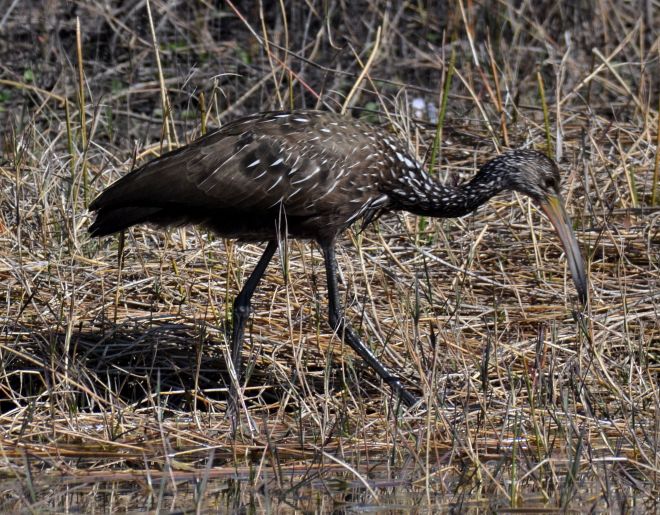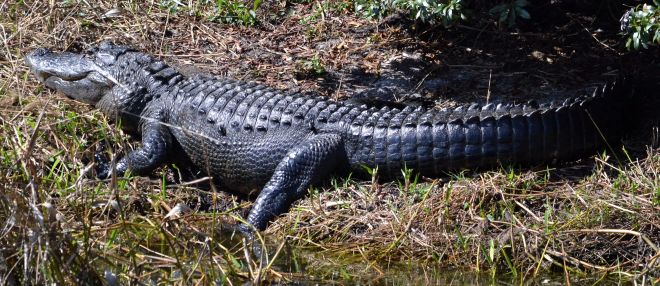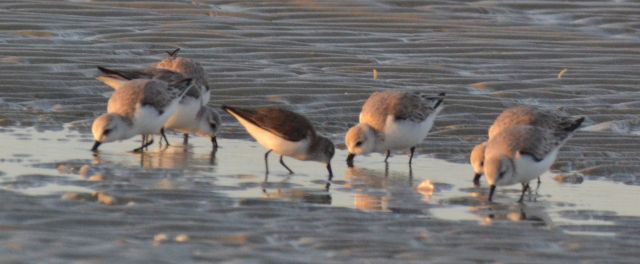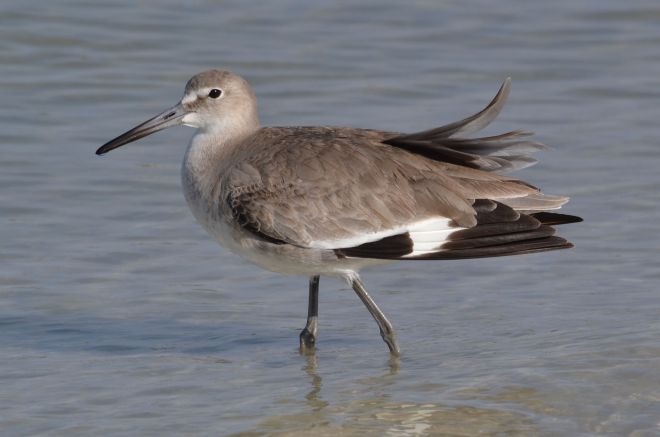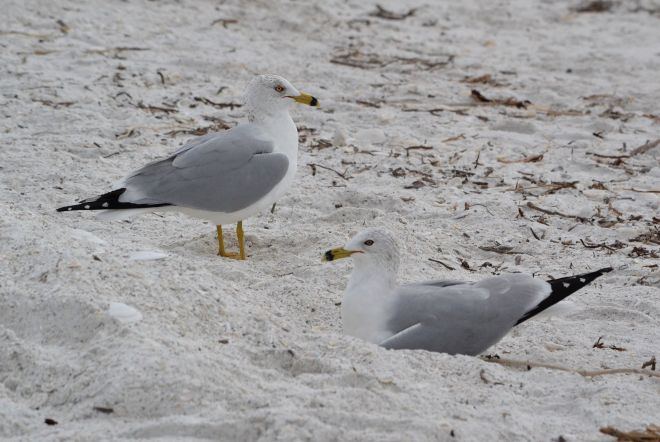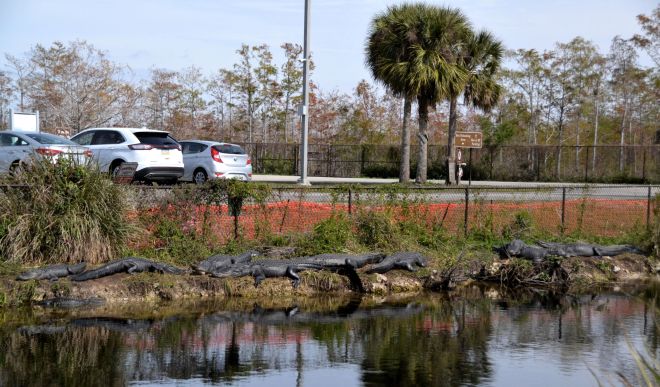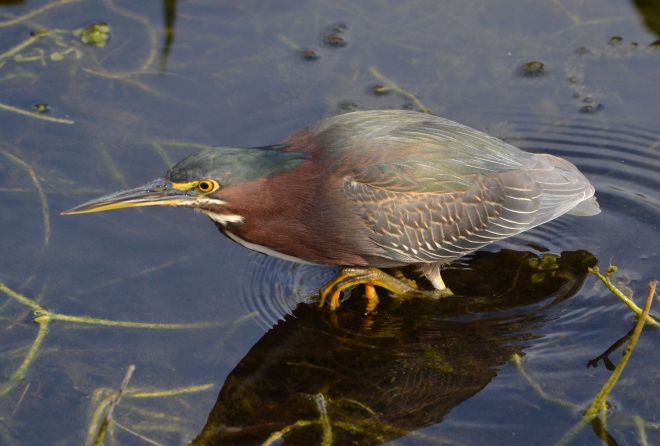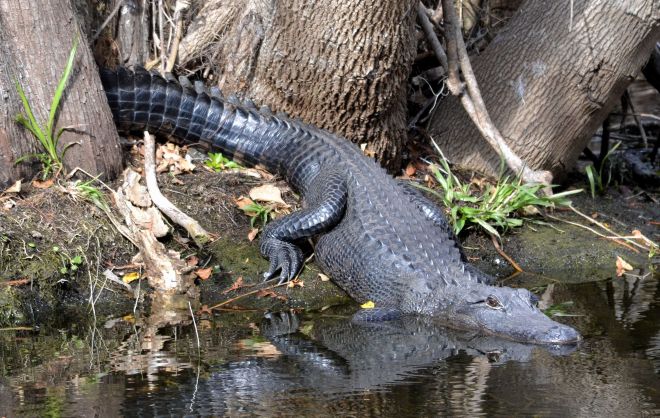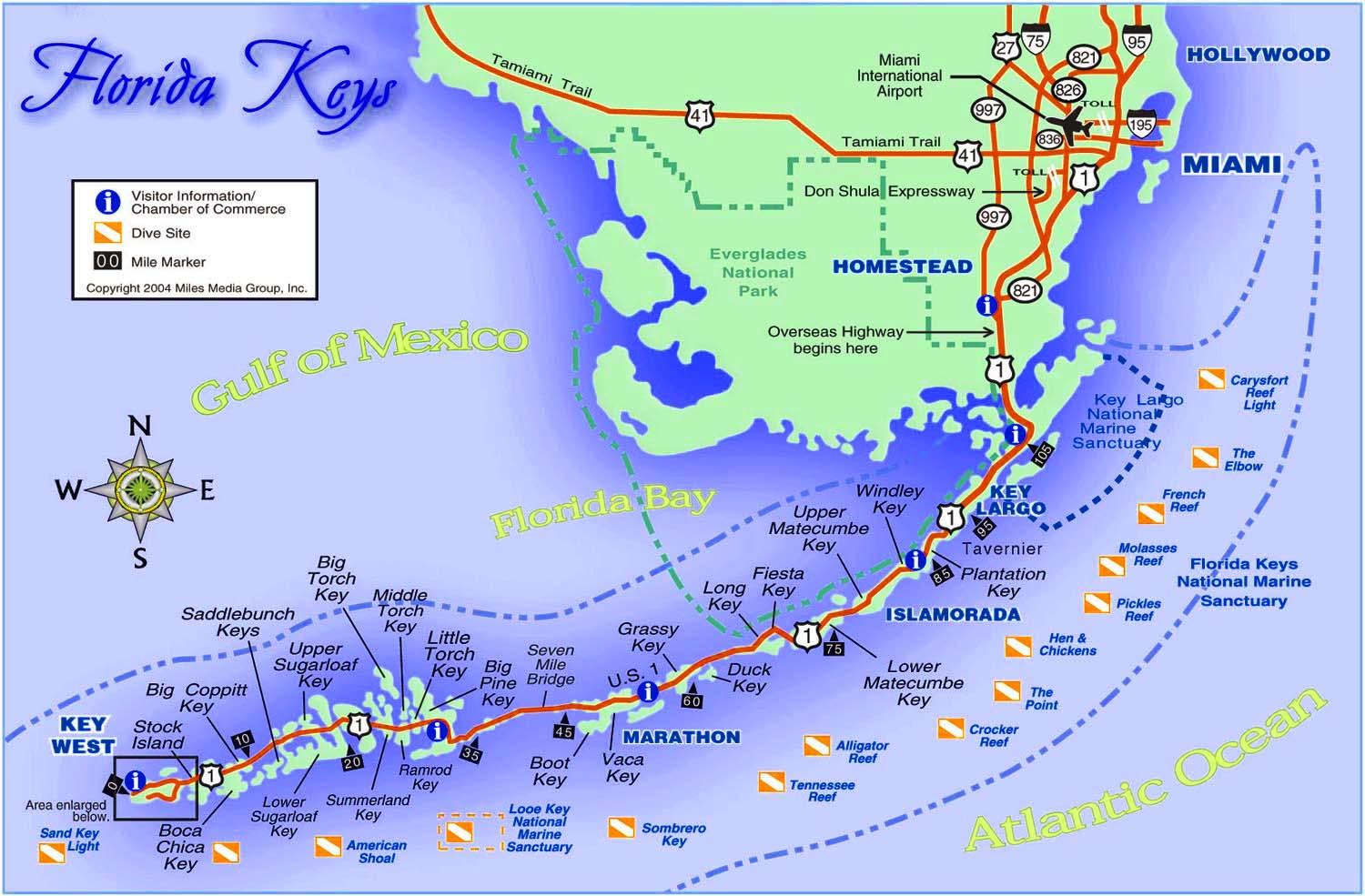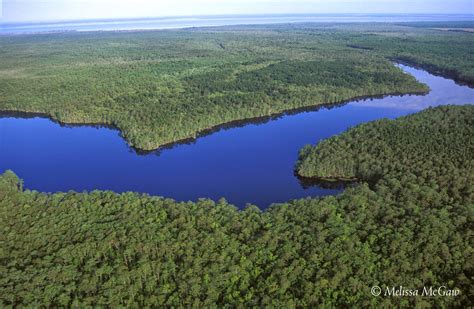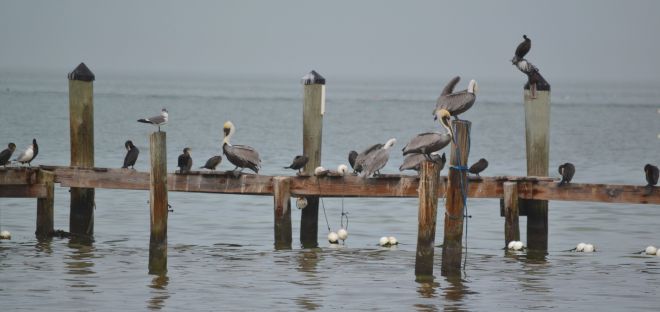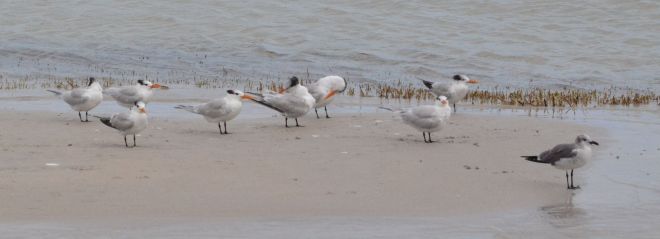The Everglades National Park, established in 1947, is described as one of the world’s most unique and diverse ecosystems. Though the park has few speciality birds it is one of the state’s most visited birding locations. My preconception like many other people’s associated it with Florida’s wading birds and large reptiles. The habitat here and the wildlife it supports depends on the natural flow of fresh water that over the last 200 years has been impacted first by detrimental extraction schemes then more recently restoration projects. Various complex biodiversity issues remain to be resolved, that having visited and learned about I now have a better understanding of. And hence my perhaps uninformed prior vision has been more realistically altered.
On 11th, having spent the previous two days driving up and down The Keys in vehicle convoys, I opted to start exploring the various access points along the one metalled road into this vast wilderness. Much of the Everglades is accessible only by boat or canoe, then back country trails and camp sites suited only to the experienced adventurer. That was not for me. A national park permit here costs $25 for seven days and so I sought value for it on five of them by visiting most of the designated public access points and some hiking trails.

Broad-winged Hawk

Red-shouldered Hawk

Boat-tailed Grackle
The SR-9336 road from my strategic junction in Homestead for the first 11 miles crosses farmland. There hawks, diminutive American Kestrel and gregarious Boat-tailed Grackle (above, right) the Florida equivalent of Jackdaw were noticeable perched on overhead wires. Of the two raptors pictured above, Broad-winged Hawk (left) winters only in the Everglades area in small numbers, so this was a good sighting. Red-shouldered Hawk (centre) was seen a number of times through this trip.
Once inside the park boundary the same flat terrain of Sawgrass prairie broken up by stands of Slash Pine, with islands or “hammocks” of hardwood woodland here and there, stretched as far as the eye could see on either side. A hammock is a grove of hardwood trees 90% of which are of tropical origin, a unique plant community found only in southern Florida and The Keys. More than 120 species of tree, shrub and other plants can be found in this habitat, many of which are listed as endangered or threatened with extinction, and a single hammock can contain 80 species. During my visits a lot of surface water was visible at the road side being farmed by numbers of Great and Snowy Egret, but this is by no means typical of all years.
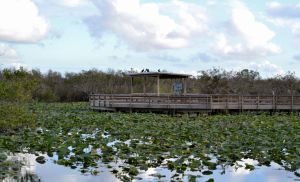
Anhinga boardwalk trail at Park Royal
My first stop was Park Royal, four miles inside the entry point, where there is a visitor centre and famous boardwalk, the “Anhinga Trail” as well as a second woodland trail. A few exotic and beautiful Anhinga were posing nicely at the trail head. My Florida reference guide to birds (see here) describes this graceful bird rather aptly as being “symbolic of the mysterious Spanish moss-draped interior of the deep south and Florida”. The Anhinga were certainly a magical sight as they stretched out their wings to dry in classic pose, while extending and withdrawing their snake-like necks at a succession of sometimes bizarre angles. The head and neck is black in males and tan in females, while juveniles appear mostly brown.

Anhinga (adult male)
Shortly afterwards I came upon the trip’s first American Alligator, that was quickly followed by another. Some Red-winged Blackbird moved through and the US species of Purple Gallinule (below, top right) were splashing about on the lily pads. But things could only be described as disappointingly quiet. Another birder told me the wintering Warblers here were mostly Palm Warbler (bottom row, below), Florida’s next most abundant after Yellow-rumped.

Birdless Anhinga blog post?

Except for these … Purple Gallinule

Palm Warbler (adult winter)
This trail has the reputation for allowing close up contact with large concentrations of “wading birds” as Herons, Storks and Ibises are termed in the US, as well as Alligators but little of this was happening. Later in the day I learned water levels are unusually high this winter so the Alligators have spread out through the park. In more normal times there can be hundreds of them piled up like logs at Park Royal where there is a permanent water flow. I immediately thought the same would be true for birds.
By 11am three school bus loads had arrived so I went off to look for quiet places in which to locate insects instead. My first finds were some medium-sized yellow butterflies and a Scarlet Skimmer dragonfly, both along a nearby road to the historic Nike missile site. The second of those insects has been introduced to Florida from East and South-east Asia.

Sleepy Orange (?)

Scarlet Skimmer
I was trying to photograph these when a passing jogger called out: “There’s a big Gator at the next water hole”. It seemed rude not to take a look and there by the roadside was the morning’s fourth and most impressive of those beasts. The official advice is not to approach within five metres but of course everyone walks right up to them. There was a kind of primeval thrill in quietly getting so close to this one as it lay slumbering in the morning sunshine. But touching or otherwise disturbing the creature was out of the question and in any case it is illegal to harass or feed Alligators. These pictures (below) were all taken from the same distance using my telephoto lens, and the subject didn’t stir.

Roadside American Alligator
After that I drove on three more miles to Big Pine campground, where there is a sleepy looking lake. Walking once around the water’s edge I found a lot of my must see dragonfly for the trip, Halloween Pennant. There are several odonata with patterned wings in the region and this is the most complex and hence beautiful of them. That was why I so wanted to see them in Florida, as well as for the sheer American-ness of the name. This species (pictured below) is native to eastern North America from Florida to Ontario, and in the southern part of its range flies all year round in wet habitats.

Halloween Pennant
To end the day I went back to Anhinga hoping some wading birds might have flown in to roost, but saw all the same things over again. A number of Double-crested Cormorant were perched on the structure of a shelter at the centre of the boardwalk. This bird could only be described as super-abundant wherever I went on the trip. Florida’s resident breeding population is swelled by vast numbers of birds from further north in winter and they must be here in their millions. By comparison with the Eurasian Great Cormorant that does also occur in North America, Double-crested is smaller with a more refined bill and orange lores in place of Great’s yellow chin patch and white throat. This juvenile (below) did indeed allow a very close approach and even I can be deadly at that range.

Double-crested Cormorant (1w?)
The morning’s first Alligator was still lying in exactly the same place at day’s end, while another big one that I christened “Smiler” was stretched out right beside the trail path and so drew a scrum of curious tourists. At one stage it went into the threat posture in reaction to all the attention, and from my this time safer range I counselled the mobile phone pointers to withdraw a little. The pictures below were all taken with a 300mm telephoto lens whilst keeping the recommended distance. What a beauty!

The Alligator subsequently known as “Smiler”

Scary or a big pussycat?

Maybe best not to put that to the test
And then came the smile (below) …
This slideshow requires JavaScript.
There are several stopping places along the 38 miles of road inside the park, all maintained by the National Parks Service. Through three more visits in as many days I gradually worked my way along these but had to wait for a reasonable showing of wading birds. Two short boardwalk trails at Mahogany Hammock (20 miles inside) and West Lake (31 miles) contained various passerines, but as in The Keys I didn’t get over involved to avoid frustration. I nonetheless invested $20 in a proper and portable field guide, Sibley Birds East the North American equivalent of Collins, to assist in my identification efforts.

Blurry B+W Warbler …

… and a hidden one

Palm Warbler (adult winter)

Palm Warbler
Above and below are some of the easier passerines in these places to put names to. I observed Black and White Warbler in a number of locations through this trip but they were always difficult to capture as the pictures convey. I had become sure of Palm Warbler IDs by now, though why one appears to be in summer plumage I will not attempt to analyse. There are different morphs and regional populations that were all too difficult to get my head around as a first time observer, and movements might have been complicated by an unusual cold snap further north during my time in Florida.

Blue and Gray Gnatcatcher

Unknown spider sp
The “Aaawwww” award for cuteness definitely goes to the rather unflatteringly named Blue and Gray Gnatcatcher (above, left), a tiny bird I also recognised on other occasions during this trip. On a different note the mangrove woodland at West Lake was draped everywhere with hundreds of thousands of the pictured spiders (above, right). For some reason these didn’t seem to spin their omnipresent webs across the boardwalk which was a relief as I didn’t know whether they were poisonous or not. Before going back I did check they were not Black Widow.
High over these boardwalks came often the sight and sound of resident Red-bellied Woodpecker. From the moment I viewed a small cluster at point blank range in a suburban garden on wandering out from my airport hotel the morning after arrival, this became one of my favourite birds of the trip. It is the commonest Woodpecker in the eastern US and they are absolute stunners. Had I not been so sensitive over carrying optics during the local school run on that first morning I might have captured equally stunning images. The following are the most interesting and unfortunately the sharpest I managed subsequently.

Red-bellied Woodpecker
I am fully aware that most of the birds I am presenting in these posts are commonplace in the US, but it was all new to me so that is OK. And it strikes me as being much simpler to puzzle over them this way than to hack out to the remotest Scottish islands or clamber around jungle clad valley sides in the Azores to tick just one at a time closer to home. There’s nothing wrong with all that of course, I’m just stating a personal preference.
On 13th when I walked two hiking trails near the far end of the road butterflies and dragonflies reclaimed the main billing. The first location, the Snake Bight Trail is said to be the best though also biting buggiest in the park. Ahead of this trip I had bought a pair of very lightweight trousers, and whilst here also invested in tropical grade, UV-proof, long-sleeved shirts. That clothing combination proved to be very cool and spraying hands and neck with repellent kept the discomfort to a minimum. But on one occasion when I forgot to protect my neck the biters soon got inside my clothing by that route.
January is the Mosquito low season but by spring time it is said to be misery to walk in places such as this, though full Mosquito-proof suits are also available from the visitor centre shops. As a further word of caution the trail distances stated on the information boards are somewhat understated. Snake Bight was clearly much longer than 1.8 miles and Bear Lake was never ending until the hurricane damage along it eventually defeated me.
It seemed a fairly limited sample of multi-brooded butterflies is on the wing in January, as in southern Europe. Throughout the trip I came across mainly the same species including Gulf Fritillary and Buckeye (both pictured below), over and again. These medium sized Nymphalidae were both present in quantity along the Snake Bight and Bear Lake trails. The former has big populations in Florida and Texas and also occurs southward through Mexico, Central America and the West Indies to South America. Buckeye, named for its conspicuous eyespots, is another common southern US and Mexican resident and significant numbers migrate into Florida for the winter months.

Gulf Fritillary

Buckeye

Gulf Fritillary

Buckeye

Gulf Fritillary
I was pleased to also cross paths at Snake Bight with my must see, Zebra Longwing that in 1996 was designated the official state butterfly of Florida. They also occur southward through the rest of the Americas and the Caribbean. This unmistakeable insect had a very light and fluttery flight pattern and seemed almost impossible to lose for long whenever I became distracted by other things.

Zebra Longwing
The range of dragonflies observed through the trip was similarly narrow. Great Pondhawk (below, left) and Banded Dragonlet continued to crop up in the Everglades as they had in the Keys. What I believe are the drab-toned female Dragonlets (to be confirmed) were the most abundant species throughout the trip, ghosting about wherever dragonflies were present. The Bear Lake trail also turned up a pleasingly coloured Roseate Skimmer (below, right).

Great Pondhawk

Roseate Skimmer
On 14th my first stop was Paurotis Pond (c25 miles inside). I had previously noted its permanent Wood Stork colony, but on this day there was at last a good concentration of large wading birds. In two hours there I also watched though distantly Roseate Spoonbill, Great and Snowy Egret, Little Blue and Tricolored Heron, White Ibis, Double-crested Cormorant and Anhinga. Some Glossy Ibis and a Belted Kingfisher flew through, Black and Turkey Vultures came and went, there was a Virginia Rail on the water and a lot of Tree Swallow over it that look more like Martins.
It being Sunday there were also some American birders around to talk to. They had mostly worked their way back from road’s end and said this was the only such gathering of birds they had seen on any of the roadside water bodies. One discussed how in his experience there has been a dramatic decline of all birds in the Everglades over the last three years.
I then moved on to Flamingo, the main visitor site at the end of the road. It was about an hour from high tide and there was a roost on the last bit of unsubmerged land. This had good numbers of American White Pelican, hundreds of Black Skimmer and Gulls, and lots of shorebirds amongst which another birder did tell me how to identify the Willet.

The offshore roost from Flamingo visitor centre (above and below)

American White Pelican

Overhead Osprey
American Pelican winter in coastal Florida from December to March and breed at inland lake sites in the north central US and central Canada, Unlike the Brown Pelican they do not dive for their food but fish co-operatively, swimming in groups to round up prey. This very distinctive and ponderous species has the second largest average wingspan (3 m) of any North American bird after California Condor, and at up to 1.8 m is also the joint longest with Trumpeter Swan.

White Pelican © Frank Schulenburg

Black Skimmer
Black Skimmer are resident along all of the Florida coast, nesting from March to September in large colonies often mixed with Tern species. They are are unique amongst birds in that the lower mandible is longer than the upper to snap prey upward from the water’s surface. I was a little disappointed not to witness the skimming feeding action anywhere on this trip. The above images, as evidenced by their clarity are both outsourced © rights of owners reserved.
Continuing to the far end of the site, a nice flock of Western Willet with some Marbled Godwit mixed in landed on a beach and let me walk right up to them. The first of those lifers, a common taller and rather stocky wintering Florida shorebird, appears quite plain when at rest but displays striking black patches once the wings are flapped. Other noticeable characteristics were the generally greyish-brown winter plumage, stout bill and thick blue-grey legs.
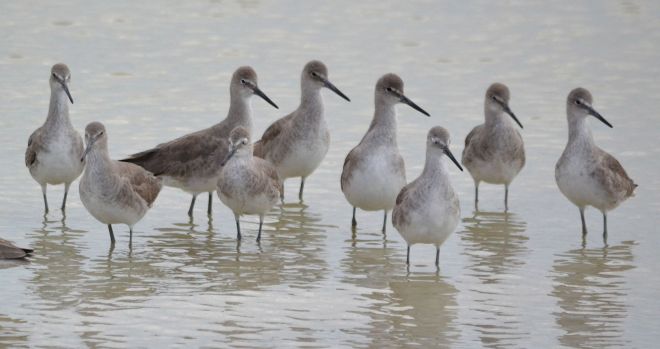
Western Willet (above and below)

Willet
There are two races. Many coastal eastern Willet move to Central and South American wintering grounds, being replaced in part by influxes of the inland breeding western race that is larger and longer-billed. They were certainly a frequent and quite charming sight throughout this trip. Marbled Godwit (below, left) is a less common, Whimbrel-sized species with long upturned bill, dark legs and attractive buffy colouration, barred beneath and mottled above. This was the only location in which I observed them.

Marbled Godwit (centre)

Surfacing Manatee
On my return to the visitor centre public attention was divided between two attractions. The first was a Manatee (above right) in the water and the second an Osprey eating a fish in a tree. There are a lot of that charismatic fish Eagle in Florida and several nests around the Flamingo site. This bird (pictured below) guzzled the fish to a constant accompaniment of begging from its mate on a nest overhead, but showed no apparent inclination to share the meal. Below one or two opportunistic Snowy Egret waited for falling scraps.
This slideshow requires JavaScript.
But what of wading birds? The lady in the visitor centre agreed that improved water distribution could be affecting numbers at present but said there’s no real pattern. These birds can be at a particular pond for a few days and then disappear again. Yes the Everglades is huge, 1.5 million protected and mostly inaccessible acres, but birds are reputed to congregate at viewable sites where there is permanent water. Whatever the reason it was plain something is still very wrong in the Everglades’ ecosystem, but this day was much more like it from a birding point of view.
There are other issues impacting on the park’s bird life. I learned from two rangers who give talks on reptiles there is a huge problem with invasive introduced Burmese Python. These snakes are all descended from a few pets released in the 1980s and now number up to 200,000. They have decimated small mammal population’s, removing 97-99% of Rabbits and Racoons and are expected to turn to birds as that food supply runs out.
At the other end of the reptile scale, pretty much the only small lizard I encountered on this trip was Brown Anole (pictured below). A resident of the Bahamas and Cuba, this is another invasive and aggressive species that has been widely introduced elsewhere through shipboard transit and via the pet trade. Now the most abundant Anole over much of southern Florida, it arrived in major seaports during the 1940s and had become firmly established by 1980, inhabiting almost any inland or coastal habitat.

Brown Anole
The lizard is capable of expanding its range very quickly and reaching high population densities, all at the expense or displacement of native species that it out-competes. This is something of a digression but further illustrates the kind of imbalances that occur when people release unwanted pets into what they think might be a nice place for them to live. The Florida Fish and Wildlife Conservation Commission lists no fewer than 40 different non-native reptiles on its website (see here).
On 16th I returned to Flamingo having acquired tide tables. First I stopped briefly at Paurotis pond again, where the Wood Stork and Roseate Spoonbill were still showing well but there were fewer other wading birds this time. In the car park there were Black and Turkey Vulture that I drove right up to and got close pictures (below) from the car window without them being at all concerned. As with Oxfordshire’s Red Kites I wonder just how so many Vultures in Florida find enough to eat. There are thousands of them everywhere, but when I occasionally passed landfill sites that did offer up one clue.

Turkey Vulture

Black Vulture
At Flamingo I engaged with a snake fancier who had found a harmless Florida Kingsnake. There is a good variety of snakes in Florida but I only saw two species on this trip, both of them being drawn to my attention by other people. This one (below) occurs widely in swamps, forests, farmland and other habitats, and like all Kingsnakes kills its prey by constriction.

Florida Kingsnake

Black Skimmer (both pictures)
The bird interest was much the same as on a day earlier but the pre-high tide Black Skimmer roost offshore (above) was very impressive. I arrived at low tide and watched the tide rising but there didn’t appear to be a marked difference between high and low. At high tide some of the seabirds would congregate in Flamingo’s marina where it was possible to get close to them.
Laughing Gull (below) was my favourite Florida Larus possibly for the simple fact it was a lifer, whereas I had recorded Bonaparte’s and the always smart looking Ring-billed Gulls previously at home. This is the most frequently encountered Gull of southern salt water beaches and marshes, though less common inland, and the only one to undergo two complete moults each year. Perhaps that helps to explain the diversity of this group (below) but I am no Gull expert.
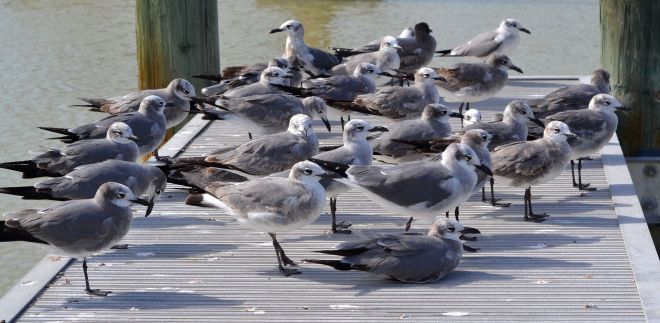
Laughing Gull in various plumages (above and below)

Laughing Gull (adult winter)

Laughing Gull (juv)

Laughing Gull (1w)
From the visitor centre a ranger was setting off to do a talk on American Crocodiles. The Flamingo complex was created to save both these, that only occur around here in the Everglades, and the marine mammal Manatee. The latter are docile and ponderous, herbivorous creatures that grow up to 4 metres in length and can weigh as much as 590 kg. Much of their time is spent grazing or sleeping in shallow waters at depths of 1–2 metres, and they surface for air at roughly 20 minute intervals. They are a frequent sight in Flamingo’s marina. Personally I found them rather boring.
I tagged along and the ranger told me where to look for Crocodiles to one side of the marina before he started. There was a huge one lying in shade with the shadow of bridge railings across it. But after the talk I found another more photogenic individual a little further upstream and soon attracted another small crowd.
American Crocodile are salt water tolerant reptiles that require fresh water in which to lay their eggs. Hence the out flowing river at Flamingo was dammed to provide this habitat and the Crocs now thrive there. By comparison with the dark skinned, exclusively fresh water American Alligator, Crocodiles are much greyer in colouration and have a pointed not squared off snout and sharper looking more closely spaced teeth. They are by any standards imposing and magnificent looking beasts (below).
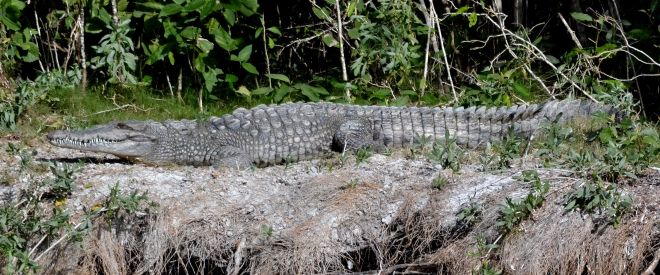
American Crocodile
Between the two Flamingo visits my attention was drawn to a 2017 report by the National Audubon Society (see here) that confirmed my own impressions and the view expressed by the American birder at Paurotis Pond. This cited almost a decade of below average wading bird nesting. Amongst the findings are:
- Destroying wetlands and altering the Everglades for flood control and water supply have reduced the amount of quality foraging habitat available to wading birds.
- Nesting of wading birds naturally fluctuates, but draining the Everglades has made it more difficult for populations to bounce back from poor nesting efforts.
- Everglades restoration projects are not being constructed fast enough to stem the decline of key indicator species.
- Key restoration projects must be built faster than the current schedule to benefit the Everglades before declines in wading bird populations hit an irreversible tipping point.
But I do not wish to quote selectively, as a press release by its nature must do. A PDF of the report may be downloaded by following the above link.
=======================
A short distance outside the national park entrance lies a small wildlife management area called Glenn Garrett Memorial Park (formerly Frog Pond WMA). On 17th I was going to try out the hammock trail next to Anhinga but a group of 20 people walked in ahead of me and so I beat a hasty retreat. Instead I decided to devote some time to the area between the park and my base, and so stopped at an interesting canal-side location that had been driven through on each day previously.
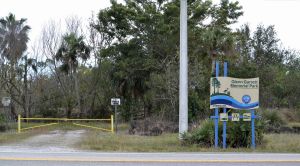
This was Glenn Garrett (above) where my attention was at once caught by two clusters of roadside butterflies. These were White Peacock and Barred Yellow that I had also encountered in several locations during the trip. The former is another Nymphalid that flies throughout the year in the US deep south, the Caribbean, Central and much of South America. It has a fast, low, erratic flight and the males are highly territorial in their behaviour, I noted a marked size variation between individuals, some of which at this site were the most attractive specimens of the trip.

Barred Yellow

White Peacock
Then a small group of shorebirds flew onto the roadside floods that turned out to be a Lesser Yellowlegs and four Killdeer (below, top). The latter is a common inland shorebird in the US, but this was the only place I saw them. Walking around I later put up an American Woodcock and had a photo-session with juvenile Tricolored Heron. The latter exhibits the captured plumage (below, bottom) between July and February .

Killdeer

Tricolored Heron (juv)
The site was a partially dried out pond that had the air of a small oasis in the surrounding agricultural land. It was a gem of a place with a small variety of dragonflies including Halloween Pennant, Band-winged Dragonlet and Black Meadowhawk, as the trans-northern hemisphere Black Darter is known in North America. Other birds noted here were Yellow-rumped Warbler, Loggerhead Shrike, and White Ibis showing they can be attractive when observed in a natural setting.

Halloween Pennant

Black Meadowhawk

Band-winged Dragonlet (fem)

Loggerhead Shrike

Foraging White Ibis

Yellow-rumped Warbler (male)
I returned to spend more time here on the afternoon of the following day (18th) though didn’t find anything new. But I did enjoy a lengthy work out with a juvenile Little Blue Heron. In white plumage these are very similar to Snowy Egret but with greenish legs, a slightly thicker, bill with a pale base, and a distinctive foraging posture with neck extended forward.

Little Blue Heron (juv)
I had been disappointed and frustrated in the Everglades by the lack of as good sightings of the wading birds I had most wanted to see here. But these seven days had offered up a rich variety of wildlife experiences, not least amongst them those exciting first encounters with the region’s large reptiles. Much more was still to come after I made my way on from here.
